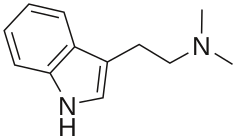This article has multiple issues. Please help improve it or discuss these issues on the talk page. (Learn how and when to remove these messages)
|
| Salvia divinorum | |
|---|---|

| |
| Vegetative habit of Salvia divinorum | |
| Scientific classification | |
| Kingdom: | Plantae |
| Clade: | Tracheophytes |
| Clade: | Angiosperms |
| Clade: | Eudicots |
| Clade: | Asterids |
| Order: | Lamiales |
| Family: | Lamiaceae |
| Genus: | Salvia |
| Species: | S. divinorum
|
| Binomial name | |
| Salvia divinorum | |

| |
| Native distribution of Salvia divinorum in Southwest Mexico[2] | |
| Part of a series on |
| Psychedelia |
|---|
 |
Salvia divinorum (Latin: sage of the diviners; also called ska maría pastora, seer's sage, yerba de la pastora, magic mint or simply salvia) is a species of plant in the sage genus Salvia, known for its transient psychoactive properties when its leaves, or extracts made from the leaves, are administered by smoking, chewing, or drinking (as a tea).[3] The leaves contain the potent compound salvinorin A and can induce a dissociative state and hallucinations.[4]
Mazatec shamans have a long and continuous tradition of religious use of S. divinorum to facilitate visionary states of consciousness during spiritual healing sessions.[1] A media panic in the Western world, especially in the United States c. 2007, centered on reports of video sharing of drug use on the internet, legal teenage use of the drug, as well as a teenage suicide in Delaware, despite it being "unclear" what role the drug played in the incident.[5] S. divinorum is legal in some countries, including the U.S. at the federal level;[6] however over half of U.S. states have passed laws criminalizing it.[7]
Its native habitat is cloud forest in the isolated Sierra Mazateca of Oaxaca, Mexico, where it grows in shady, moist locations.[8][9] The plant grows to over a meter high,[1] has hollow square stems like others in the mint family Lamiaceae, large leaves, and occasional white flowers with violet calyxes. Botanists have not determined whether S. divinorum is a cultigen or a hybrid because native plants reproduce vegetatively and rarely produce viable seed.[10][11]
Because the plant has not been well-studied in high-quality clinical research, little is known about its toxicology, adverse effects, or safety over long-term consumption.[3][4] Its chief active psychoactive constituent is a structurally unique diterpenoid called salvinorin A,[4][12][13] a potent κ-opioid agonist.[14] Although not thoroughly assessed, preliminary research indicates S. divinorum may have low toxicity (high LD50).[15][16] Its effects are rapid but short-lived.[3]
- ^ a b c Valdés, Díaz & Paul 1983, p. 287.
- ^ a b "Salvia divinorum Epling & Játiva". Plants of the World Online. Royal Botanic Gardens, Kew. Retrieved 21 December 2022.
- ^ a b c "Salvia divinorum". Drugs.com. 2018. Retrieved 8 January 2018.
- ^ a b c Butelman, Eduardo R; Kreek, Mary Jeanne (2015). "Salvinorin A, a kappa-opioid receptor agonist hallucinogen: Pharmacology and potential template for novel pharmacotherapeutic agents in neuropsychiatric disorders". Frontiers in Pharmacology. 6: 190. doi:10.3389/fphar.2015.00190. PMC 4561799. PMID 26441647.
- ^ "'Salvia Killed My Son,' Says Mother". ABC News. 2009-02-02.
- ^ "Salvia Divinorum and Salvinorin A 2020" (PDF). Drugs and Chemicals of Concern. Diversion Control - U.S. Department of Justice - Drug Enforcement Administration (DEA). March 2020. Archived (PDF) from the original on 18 April 2020. Retrieved 7 December 2022.
Street Names: Maria Pastora, Sage of the Seers, Diviner's Sage, Salvia, Sally-D, Magic Mint
- ^ "Salvia Divinorum and Salvinorin A 2008". Drugs and Chemicals of Concern. Office of Diversion Control - U.S. Department of Justice - Drug Enforcement Administration (DEA). June 2008. Archived from the original on 22 June 2008. Retrieved 15 September 2008.
- ^ Cite error: The named reference
Reisfield1993introwas invoked but never defined (see the help page). - ^ Valdes 1987, p. 106.
- ^ Marushia 2002, p. 3.
- ^ Cite error: The named reference
Reisfield1993barrierwas invoked but never defined (see the help page). - ^ Prisinzano 2006, p. 527.
- ^ Imanshahidi & Hosseinzadeh 2006, p. 430.
- ^ Cite error: The named reference
Roth2002pabstractwas invoked but never defined (see the help page). - ^ Cite error: The named reference
Mowry2003p382was invoked but never defined (see the help page). - ^ Grundmann 2007
